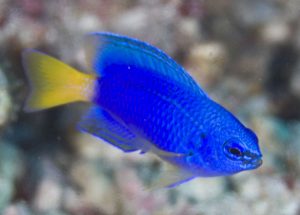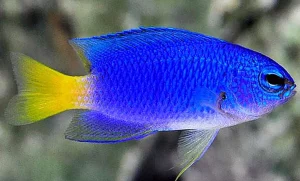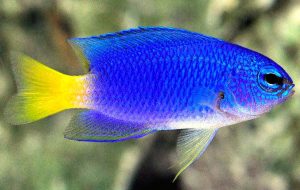Similar Damselfish (Pomacentrus similis) known to tropical fish keeping enthusiasts as Similis Damselfish or Similar Damsel is a species of “neon” damselfish indigenous to Sri Lanka, the Andaman Sea, the Cocos and Christmas Islands, Bali, and Java in the Indian Ocean.
Adult Similar Damselfish are found alone, in pairs, but more often in medium to large schools over Acropora type coral heads and rocky reefs at depts between 6 to over 50 feet where they feed among the substrate.
Like Azure Damselfish (Chrysiptera hemicyanea), Pomacentrus similis are a non-migratory, reef dependent species that feed on small crustaceans, microalgae, and zooplankton among the substrate during daylight hours, and shelter among the coral branches during the night for protection from predators. One or two dominant males will usually defend a single branching SPS coral head with a harem of juveniles and females, and in return for the shelter provided by the coral, remove unwanted algal growth.
Similar Damselfish are occasionally found living in a symbiotic relationship with various species of anemones.
Similar Damselfish have a dark neon blue colored body, dorsal, and ventral fins, and a bright yellow tail that ends at the base of the caudal fin. Many tropical fish keeping enthusiasts commonly misidentify Similar Damselfish as Yellowtail Blue Damsel fish (Chrysiptera parasema) however, unlike Yellowtail Damsels; the yellow coloring of Similar Damselfish does not extend onto the body, but ends abruptly at the base of the tail. Both species have a black horizontal line across the eye. Compared to Pomacentrus alleni, Similar Damselfish have a proportionally taller body.
Similar Damselfish are less aggressive than other damsels and do not require as large of an aquarium. They are happiest in a small, odd numbered shoal where they can chase each other to establish a pecking order of sorts.
A small odd numbered group of Similar Damselfish can be housed in a mature FOWLR or reef aquarium of at least 30 gallon capacity with a sand or fine gravel substrate and plenty of live rock arranged into crevices, caves, and overhangs for them to hide among. Similar Damselfish are completely reef safe and will not disturb corals or invertebrates in a reef tank. Although solitary individuals will occasionally become territorial towards their own kind or similar sized fish, they generally ignore other fish in a peaceful species tank.
Larger tanks with plenty of live rock are required for keeping large shoals of Similar Damselfish with other peaceful to semi aggressive fish species. Juveniles are generally passive to semi aggressive but can become more territorial as they grow into adults, especially when sufficient hiding places are not available in the tank.
Although Similar Damselfish have been successfully bred in captivity, their larvae are difficult to rear. Mated pairs follow a benthic egg laying cycle. After a brief courtship “dance”, the female lays her small adhesive eggs on a rock or shell on the substrate. After the male fertilizes the demersal eggs, he guards and aerates them until they hatch. The tiny fry in their larval stage will drift with the current as plankton feeding on zooplankton and phytoplankton before settling to the bottom as partially developed damselfish. Males will often mate with multiple females in the harem during the spawning season.
Similar Damselfish are omnivores that in their natural habitat feed on zooplankton and algae. In an aquarium environment they are ravenous eaters that will accept most meaty and herbivorous preparations. Small portions of Brine Shrimp, Spirulina Flakes, Frozen Foods, Mysis
, Zooplankton
, and finely chopped seafoods should be fed several times a day to minimize aggression in the tank.
Similar Damselfish (Pomacentrus similis) are available to tropical fish keeping enthusiasts in specialty fish stores and from online wholesalers, trans shippers, and retailers at prices varying from $4.99 to $11.99 at approximate purchase sizes: Small 1/2″ to 1″, Medium 1″ to 2″, Large 2″ to 3″.
Minimum Tank Size: 30 gallons
Aquarium Type: Reef or FOLR
Care Level: Easy
Temperament: Semi Aggressive
Aquarium Hardiness: Very Hardy
Water Conditions: 74-80°F, dKH 8 to 12 , pH 8.1 – 8.3, sg 1.023-1.025
Max. Size: 2.8″
Color Form: Blue, Yellow
Diet: Omnivore
Compatibility: Reef
Origin: Indo Pacific, Sri Lanka, Indonesia
Family: Pomacentridae
Lifespan: 3-5 years
Aquarist Experience Level: Beginner





One Response to “Similar Damselfish (Pomacentrus similis)”
Trackbacks/Pingbacks
[…] Similar Damselfish (Pomacentrus similis), Chrysiptera rollandi are a peaceful, non-migratory, reef dependent species that feed on small […]